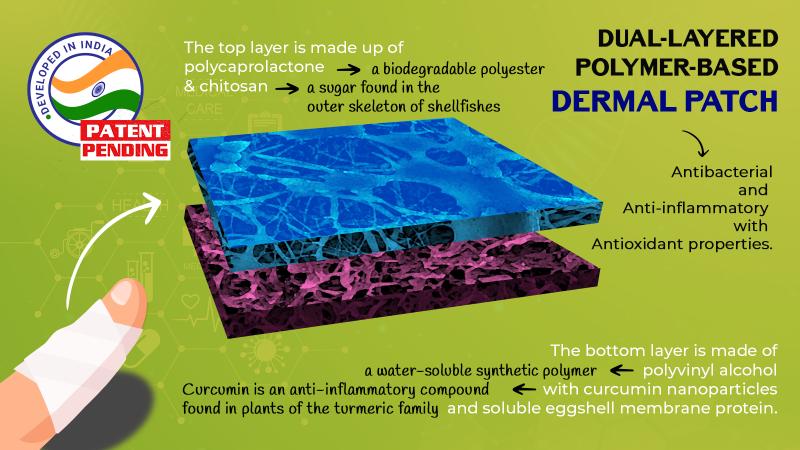
Image Credits: Scientifickly
Wound dressings have evolved considerably from the herbal concoctions and magical potions that were popularly accepted as therapy, until the 19th century. Today, wound care is no longer just using a piece of gauze dipped in Dettol. With bioactive agents, nanoparticles, antioxidant agents, growth factors, polymers and more, the science of wound healing is advancing continually.
In a recent study, Prof. Prakriti Tayalia and her team from Indian Institute of Technology Bombay have developed an affordable bilayered bandage with antibacterial, antioxidant and anti-inflammatory properties. The top layer consists of polycaprolactone (a biodegradable polyester) and chitosan (a sugar found in the outer skeleton of shellfishes). The bottom layer is made of polyvinyl alcohol (a water-soluble synthetic polymer) with curcumin (an anti-inflammatory compound found in plants of the turmeric family) nanoparticles and soluble eggshell membrane protein. Their research was published in the journal Nanomedicine: Nanotechnology, Biology, and Medicine, with the lead author being Dr. Mamatha M. Pillai, who is a Postdoctoral Fellow in the lab.
There are, currently, more than 3000 different wound healing dressings available in the market, each being appropriate for specific wound types, that is for wounds that are more severe than the average paper cut. But, even with this plethora of choices, wounds such as venous ulcers, pressure ulcers, burn wounds, and diabetic wounds are challenging to treat.
The impediment in the case of chronic and acute wounds – that are complex and hence do not progress through a regular sequence of skin repair – is the poor antioxidant and anti-inflammatory properties of the dressing leading to drying up of the wounded area and the requirement for frequent change of the dressings.
Now, it makes sense for a dressing to be antibiotic or antiseptic. But why are the antioxidant and anti-inflammatory properties of a wound dressing so significant? Well, when a body is wounded, it goes into a frenzy of molecular operations to heal itself. An abundance of fighter blood cells, clotting factors, and other mediators arrive at the wound site in phases to ‘help’. In certain cases such as chronic wounds, the frenzied efforts of the body to heal itself end up being more harmful than beneficial.
Chronic wounds do not easily surpass the inflammatory stage of wound healing, during which the molecular operations focus on removing damaged cells and bacteria from the wound site. This leads chronic wounds to accumulate inflammatory molecules and free radicals at the wound site that prevent it from entering the next stage, which is the reconstruction phase.
In such scenarios, especially with severe wounds, the wounds would benefit from dressings equipped with antioxidant and anti-inflammatory properties, while remaining non-toxic. The dressing must also allow absorption of excess wound discharge while at the same time maintaining a moist milieu for the cells to heal.
The dermal patch proposed by the IIT Bombay team meets all these criteria. It includes in the top layer polycaprolactone and chitosan. Polycaprolactone is commonly used in tissue engineering due to its water repelling, biocompatible and biodegradable properties and is approved by the Food and Drug Administration, United States (FDA). The polymer chitosan, also FDA approved, is antibacterial and biodegradable. The combination of these polymers serves as a moisture-repellent layer for maintaining the fluid balance at the wound site and providing a microbial barrier for advanced wound healing.

A picture of the nanofibrous dermal patch (Copyright - Cell and Tissue Engineering Lab, IIT Bombay)
For the bottom layer, the team used polyvinyl alcohol, which serves as an aqua sponge embedded with wound healing agents, an absorbent for wound discharge, and a moist ambience for the wound. As far as the wound healing agent is concerned, remember the good old days when one would apply turmeric paste on wounds for quick healing? Well, Prof. Prakriti Tayalia and her team used a bioactive component from turmeric – curcumin – for the dermal patch.
Curcumin is known to have potent antibacterial and anti-inflammatory properties. They converted the curcumin to nanoparticles to make the curcumin more easily accessible at the wound site. They also used an eggshell membrane – the thin layer that’s between the egg white and the shell – which contains a high volume of structural proteins that can expedite wound healing.
“To our knowledge, there are no such wound dressings available that are polymer-based, dual-layered, topical in application with multifunctional properties, namely, antibacterial, anti-inflammatory, antioxidant, leading to better wound healing properties. This invention is innovative, and we have filed a patent on it,” says Prof. Tayalia.
The researchers have studied and validated the wound healing properties of the dermal patches with multiple lab tests. They also tested the patches on rat models and observed improved wound healing in comparison to other commercially available dressings. Next, the researchers plan to test it on diabetic and other chronic wounds.
Since the materials used to develop the patch are easily accessible, the process can be effectively scaled up for industrial mass-production of the patches for the market. The patches are only a couple of millimeters thick and can be manufactured in any size.
“This patch will undoubtedly be beneficial to people suffering from both chronic and acute wounds and we want to commercialize this product,” Prof. Tayalia signs offThis article has been run past the researchers, whose work is covered, to ensure accuracy.
This article has been run past the researchers, whose work is covered, to ensure accuracy.






